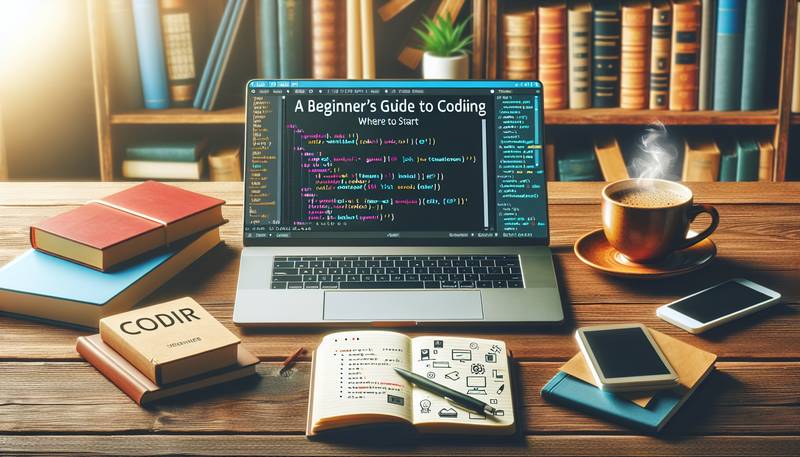A Beginner's Guide to Coding: Where to Start

Embarking on the odyssey of coding might seem daunting at first, but fear not, intrepid explorer of the digital realms! Coding is not a cryptic art reserved for the few; it is a skill that can be learned and mastered by anyone with a dash of dedication and a sprinkle of curiosity. This guide is your compass, pointing you in the right direction as you begin your journey. We will walk through the very foundations of coding, help you pick the language that will become your mother tongue in the tech world, show you the treasure troves of learning resources, and share secrets on how to practice effectively. So gear up, future coder, as we set the course for your adventure in coding. Let's decode the code!
Understanding the Basics of Coding
Before you take the plunge and start writing lines of code, it's essential to familiarize yourself with the building blocks of programming. Think of coding as constructing a skyscraper. Just as you can't start without a blueprint, a foundation, and the right materials, you can't begin coding without understanding its core elements. Coding is creating a set of instructions for computers to perform specific tasks. These instructions, known as code, are written in various languages that computers can interpret and execute.
At the heart of coding are principles such as variables, which act as storage containers for data; functions, which are like specific commands you can call upon to perform tasks; and control structures, such as loops and conditional statements, which dictate the flow of your program. For instance, a loop might tell a computer to keep doing something until a particular condition is met, like repeating a song until you tell it to stop. Conditional statements, on the other hand, allow for decision-making processes in your code, like a crossroads where only one path can be taken based on certain conditions.
Understanding these concepts is crucial, as they are the universal spine of all programming languages. Grasping them will not only ease your initial learning curve but will also give you the flexibility to adapt to different programming languages in the future.
Choosing the Right Programming Language
Choosing a programming language is like choosing your first car. You want one that's reliable, suits your style, and takes you from A to B without a hassle. In the same way, your choice of a programming language should align with your interests and what you want to build. For beginners, some friendly languages make a good starting point, and they all have their unique flavors.
Python, for example, is like the friendly neighborhood car that's easy to drive and versatile. Known for its straightforward syntax and readability, Python is perfect for tasks ranging from web development to data analysis and machine learning. JavaScript, on the other hand, is the off-road vehicle that takes you everywhere on the web. It's the language of the web browsers, making it indispensable for front-end development and increasingly for back-end with environments such as Node.js. Ruby, with its elegant and concise code, is akin to a classic convertible, making it a joy to build web applications with frameworks like Ruby on Rails.
In choosing your first programming language, consider what you want to do. Do you have a burning passion for creating websites? Dive into JavaScript. Are you intrigued by artificial intelligence or data science? Python might be your calling. Or maybe you're drawn to developing web applications with a friendly community and elegant syntax? Give Ruby a go. Remember, this is not a lifelong commitment; it's about getting started. You can always learn another language once you've got the hang of the first one.
Resources for Learning to Code
With a chosen language in hand, it's time to begin the quest for knowledge. Fortunately, the world of coding is rich in resources for eager learners. A multitude of online platforms offer courses tailored to beginners, ranging from free tutorials to paid, in-depth classes.
Interactive learning sites like Codecademy and freeCodeCamp allow you to write code directly in your browser and see the results of your work instantly. These platforms guide you through the basics and provide projects to apply what you've learned. If you're a fan of video tutorials, platforms like Udemy and Coursera host courses created by professionals in the field. Many of these offer a structured pathway that takes you through beginner to advanced levels, all at your own pace. For a more university-style approach, edX and MIT OpenCourseWare give access to lectures and materials from actual college courses, often for free.
Besides these structured courses, don't forget the wealth of knowledge available in books, community forums, and coding blogs. Books written by seasoned programmers can provide insights and in-depth analysis that you might not find in online courses. Forums like Stack Overflow are invaluable when you run into specific problems or need advice from the coding community. Blogs not only keep you updated on the latest trends in technology but also often contain tutorials and tips for best practices.
Remember, the best resource out there is the one that works for you. Some may prefer interactive coding environments, others learn best by watching videos or reading books. Mix and match these resources to suit your learning style and goals.
Practice Makes Perfect
As with any new skill, practice is vital in coding. Understanding the theory behind the code is one thing, but the magic happens when you start writing it yourself. The best way to learn is by doing, making mistakes, and then learning from them. Start by coding simple applications, and as your confidence builds, take on bigger projects.
One effective way to practice is by working on personal projects. Passion projects will not only engage you more, but they will also push you to apply your knowledge creatively. For instance, you could build a personal blog, a calendar app, or a small game. Don't worry about perfection or complexity; the goal is to get your hands dirty and learn from the process.
Another fantastic way to practice is to engage in coding challenges. Websites like HackerRank, CodeSignal, and LeetCode offer a plethora of problems to solve, ranging from easy to very hard. These challenges are a great way to sharpen your problem-solving skills and can be quite addictive!
Lastly, contributing to open-source projects can be highly rewarding. It's a practical way to practice coding in a real-world setting, collaborate with other developers, and contribute to the community. Platforms like GitHub and GitLab are home to thousands of open-source projects looking for contributors. Start with documentation or simple issues and gradually move to more significant contributions as your skills grow.
Staying Motivated on Your Coding Journey
Staying motivated while learning to code can sometimes be challenging. There will be days when you're stuck on a problem or when code simply won't run, no matter what you do. It's all part of the journey. The key to staying motivated is to set clear goals and celebrate small wins along the way.
Begin by setting realistic and achievable goals. For example, 'I will code for 30 minutes every day' or 'I will build a simple website in two weeks'. These goals give you a clear direction and a sense of purpose. Celebrating small achievements helps you to track your progress and keeps you motivated. Every time you understand a new concept, fix a bug, or complete a challenge, take a moment to acknowledge and celebrate it.
Joining a community of fellow learners can also be incredibly motivating. Coding can sometimes feel lonely, especially when you're stuck. However, many others are on the same journey, facing similar challenges. Communities, either online or in-person through meetups, hackathons, and coding clubs, can provide support, encouragement, and shared learning experiences.
Lastly, it helps to remember why you started coding in the first place. Whether it's to change your career, build something incredible, or simply to challenge yourself, keeping your end goals in mind can be a powerful motivator. Don't lose sight of the forest for the trees; every small step is a step closer to where you want to be.
Conclusion
Congratulations, brave adventurer, on reaching the end of this beginner's guide to coding. You are now armed with the knowledge of where to start, the tools to learn, and the secrets to practice and stay motivated on your journey. Coding is a voyage of continual learning and growth, and you've just set sail.
Remember that every expert was once a beginner. The path ahead may seem long, but with each line of code, you're building more than just software; you're building your future. Coding is not merely about typing on a keyboard; it's a way of thinking, solving problems, and creating something out of nothing. It grants you the power to bring ideas to life, and that is something truly magical.
Embrace the challenges, relish the victories, and, most importantly, enjoy the journey. The world of coding is vast and full of possibilities. With dedication, perseverance, and the spirit of exploration, there's no limit to what you can achieve. Keep coding, keep learning, and who knows—you may be the one writing a guide for future beginners one day. Happy coding!


